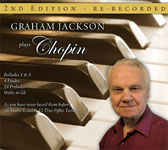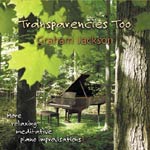The Music & Writings of Graham Jackson
Recordings
GRAHAM JACKSON PLAYS CHOPIN
FREDERICK CHOPIN (1810-1849), born in Poland, spent the second half of his short life in Paris, where he was enthusiastically taken up by society. This recording, following a recital on June 4, 2010, has been made partly to celebrate the 200th anniversary of his birth. Although he died at 39, he is still celebrated as “the poet of the piano” and his prolific output is still beloved of pianists.
In Paris, Chopin often went to the opera, and one can well surmise that the many beautiful melodies in his pieces were influenced by the bel canto operas of Bellini and others.
His harmonies however are uniquely original, especially for that time. It is not only the succession of harmonies, but the vertical sonority of each chord—which notes are included, which omitted, and in what spacing—which is exquisitely calibrated for maximum beauty of effect in the context.
He took full opportunity of the new steel-framed grand pianos, which could have their strings tuned at a greater tension. These gave a much fuller sound, and Chopin loved to make the piano resound, even thunder at times.
* * *
PROGRAM NOTES:
BALLADE No. 1 in G Minor, Op. 23. The first of four, this ballade has something from all sides of Chopin—the drama, the lyricism, the sweeping melodies, the tempestuous virtuoso passages and triumphant conclusion.
BALLADE No. 3 in Ab Major, Op.47. This Ballade is said to be based on the old folk-tale, found in various countries, of the mermaid, or undine, who aspires to come out of the water and live on land, among humans. When her wish is granted, she goes to a ball, a prince falls in love with her and she is enabled through his love to stay. They are of course married and live happily ever after.
The narrator begins the story and we soon hear the beautiful theme of the mermaid, preceded by descending octaves. When it comes again, we hear the tenor voice of the prince join in duet with her, the prince takes her hand and they begin to dance a graceful waltz. Later there seems to be a somewhat ominous scene underwater, but everything turns out fine in the end.
Incidentally, you can tell with many younger pianists these days that they have never danced a waltz. Of course it is not part of their culture, just as I have never danced a minuet. Still, it is not inaccessible. They should try it--they might like it!
ETUDE in A Minor, Op. 25, No. 11 –Known as The Winter Wind, this piece is a favourite challenge for the pianist’s dexterity. At the same time, the constant subtle shifting of the sonorities created by the wildly blowing “wind” is a delight. This is enhanced by preserving the rapid triplet rhythm asked for, whereas many performances obscure this by being seduced into bringing out instead the descending chromatic scales.
ETUDE in C# Minor, Op. 25, No. 7 –This rarely heard study has unique beauties. Sounding at times like a cello piece, its left-hand melody sings an expressive meditation, occasionally unleashing its latent power in a torrent of notes, then returning to its introspective musing.
ETUDE in Gb Major, Op. 25, No. 9 –Known as the “Butterfly Etude”, this cheerful trifle flutters about with Chopin’s enchanting harmonies.
ETUDE in Ab Major, No. 2 from Trois Etudes (posthumous) –Again the interest is in the constantly shifting harmonies rather than in the merely suggested melody. As well, the 2-against-3 rhythm in the two hands calls attention to the rhythmic web created by the repeating chords, a seamless ethereal fabric that the player can manipulate by stretching and compressing its elastic substance with moving effect, taking care not to break it.
TWENTY-FOUR PRELUDES, Op.28
This set of Preludes is a fascinating work that could remind one of Mussorgsky’s Pictures at an Exhibition in the wonderful variety of its styles and images. I have even ventured to suggest some pictures for some of them. You are welcome to ignore them if you like, or find your own.
PRELUDE No. l in C Major –A robust opening that briefly sets the stage.
No. 2 in A Minor –Its funereal introspection, coming so soon, when we have just begun, can feel frustrating, but we are soon cheered up.
No. 3 in G Major –A fleet-footed romp, like a scene from A Midsummer Night’s Dream.
No. 4 in E Minor –Another meditative contemplation.
NO. 5 in D Major –A busy scene, perhaps in a market-place, with a lot going on at once.
No. 6 in B Minor –This feels to be underwater. The upward arpeggios float effortlessly like bubbles to the top.
No. 7 in A Major –An utterly simple statement—direct, healthy, perfect in its logic and form.
No. 8 in F# Minor –Not so healthy, it is marked molto agitato. This person is so worried and anxious as to be almost neurotic, except for a short bit of blessed peace near the end.
No. 9 in E Major –A deep reassuring voice brings the steady presence of a mature wisdom.
No. 10 in C# Minor –Brilliant, light and sparkling, as natural as birdsong, or a tumbling cataract, it is over almost too soon.
No. 11 in B Major –As light as air, one feels this is really a butterfly piece. If it is a dancer or eurythmist, she has to be particularly light and graceful.
No. 12 in G# Minor –Very different, this sounds like a sturdy peasant woman with very full skirts, busy in a market-place.
No. 13 in F# Major –A sustained meditation, open to deep thoughts.
No. 14 in Eb Minor –Two men are very busy doing something in the dark.
No. 15 in Db Major –The famous Raindrop Prelude, with its quietly beautiful melody against the backdrop of the constantly dripping raindrops.
No. 16 in Bb Minor –A sort of Flight of the Bumblebee, careening everywhere at great speed. It seems lighter than a bumblebee, however. Maybe call it Flight of the Nimblebee.
No. 17 in Ab Major –We settle into the repeated chords as if into a comfortable armchair, as Chopin continually massages and varies them. He demonstrates here much he evidently loved to make the instrument resound with its full possibilities.
No. 18 in F Minor –More prickly than usual for Chopin, this one to me suggests a very different image—seen from above, a lonely little homestead where a single couple live in the American mid-West, a pickup truck and maybe a rusty old car in the yard.
No. 19 in Eb Major –Again very different, this beautiful prelude brings us back to the elegant world of 19th century Warsaw or Paris. With its constant huge leaps in both hands, it suggests he wants the whole range of the keyboard to sound at once, which is a challenge especially for any pianist not equipped with large hands.
No. 20 in C Minor –Full chords, deep and slow, with a certain grandeur, again let the new grand piano resound with its full depth.
No. 21 in Bb Major –While a lovely melody soars above, it is as if flowers repeatedly come rapidly from seed to blossom within a single bar. Then alternating harmonies of sheer beauty sound up from the depths. Finally a falling cascade of these flower petals blankets us and we sink into the welcoming bosom of earth. For me, however, in the last section, the image keeps intruding of a crowd of portly bankers in suits descending a flight of steps outside a building…
No. 22 in G Minor –An outburst of righteous anger can be very satisfying.
No. 23 in F Major –All sweetness and light, this prelude to me seems to be in baby pink and blue.
No. 24 in D Minor –A driving rhythm in the leaping bass carries us relentlessly through a paroxysm of will and intensity. Bursts of virtuosity, like rockets among fireworks, announce that this is the finale.
WALTZ in Gb Major, Opus 70, No. 1 (posthumous) –A sparkling little encore, again with some challenging leaps in both hands.
* * *
TWELVE TRUE-FIFTHS TUNING: Maria Renold (1917-2003) was a professional viola-player who, playing in string quartets, struggled with tunings for decades, until in 1962 she hit on this tuning, which some just call the Twelve Fifths Tuning. The point of it however is that in today’s equal-tempered system, none of the 5ths are true natural 5ths as found in the overtone series, whose frequencies are exactly in the proportion 3/2. That is because a piano-tuner tunes each note a 5th above the previous note, in what is called the circle of 5ths. However, if he uses natural 5ths, he will find on returning after 12 steps to the beginning note, he has overshot a little bit. Hence he makes each 5th slightly smaller to make them fit. Thus we never hear the pure, ringing 5th on a keyboard instrument. Choirs and string players constantly adjust a little to make it possible.
Briefly, in this tuning, you tune the white notes on the piano—the 7 notes from F to B—in natural 5ths. You then find the exact middle of the C octave—F#/Gb—and tune the black notes—the next 5 notes—from there, again in natural 5ths. You thus have two series of natural 5ths, linked by a new interval, called a “formed 5th” between B-F#, and Bb-F.
This interval however satisfies because it is based on one of the three systems underlying all real scales in all cultures—the overtone series, the undertone series, or equal divisions; or in mathematical terms—arithmetic, harmonic or geometric proportion, respectively. Apparently, intervals derived from valid intervals are also valid. Thus, the equal division of the octave in half created these two valid bridging 5ths. Ultimately, our inner experience is the judge.
There is a further refinement, however, she discovered later, and which, when added, makes the tuning what its fans call “Renold II”. That is, remarkably, that one can slightly expand the 5ths—and hence the octaves—slightly past the mathematical interval and find a satisfying interval that still works.
This tuning is based on an indication by Rudolf Steiner, on whom she based all her work. It is a constant source of amazement how deeply Steiner was able to penetrate virtually every sphere of knowledge (he was not a musician) and uncover new insights and information.
My first two CD’s—Transparencies and Transparencies Too, (which are relaxing, meditative, improvisations) were made in the earlier tuning. This one however has the expanded octaves, and the increased resonance is immediately apparent.
ABSOLUTE PITCH A=432 hz –
The other, equally important, difference from the usual tuning is the use of a lower pitch altogether. Rudolf Steiner said our concert pitch—which has varied a great deal over the last few centuries—is too high. A=440 hz causes stress in our souls and bodies because the pitch that is tuned to our organism is not that one, but A=432 hz, corresponding to C=256 hz, (or 128). Maria Renold tested the differences on audiences in America and Europe for decades, and found that when they listen carefully, ordinary people have a remarkable ability to hear this tiny difference and register it in the way they feel. Consistently about 90% preferred the A=432, without knowing which they were hearing. The higher one was brighter and more brilliant, but stressful. Still lower pitches were not necessarily better. A=432 was just right.
She tells many anecdotes of singing teachers finding their pupils can sing more on pitch and with less strain, or classes of children being more relaxed, or how the music goes more deeply into people, etc. Those with not quite “absolute pitch” could remember this pitch although not others. Verdi apparently advocated this pitch, and there is an international movement to adopt it, with some world-famous singers as members.
She says that when using this new tuning, it should always be with this pitch, because experience has shown that it otherwise makes people irritable. However, even just adopting this pitch could contribute a little bit to bringing peace in the world.
When testing people on this pitch she also found that it only worked when live instruments were used. Somehow, electronic reproduction levels out qualities. Hence a recording like this could also be seen as ineffective. However, I believe it is better than nothing in acquainting people with it, and it can be seen as an experiment. As far as I know, it is the first such attempt anywhere, to record classical music in this tuning.
Just as J.S. Bach in his Well-Tempered Clavichord, wrote 24 Preludes and Fugues to demonstrate that, with the new, almost equal-tempered, tuning, one could play in all keys, Chopin wrote his 24 Preludes, one in each of the 12 major and 12 minor keys. Although the Twelve True-Fifths Tuning was only invented a few decades ago, Chopin’s work can just as well be used to demonstrate that this tuning also works in all keys.
Further information on the pitch and tuning can be found in Maria Renold’s very detailed book: Intervals, Scales, Tones and the Concert Pitch C=128 hz by Maria Renold (pub. 2004 Temple Lodge, U.K) (or in German: Von Intervallen, Tonleitern, Toenen und dem Kammerton C=128 Hertz, Verlag am Goetheanum, Dornach, 1998)
A brief and practical outline is The Scale of Twelve Fifths—a Handbook on the Middle Tuning, by Bevis Stevens, (Mercury Press) available at Meadowlark Toys and Crafts (formerly Sunbridge College Bookstore) 817 Chestnut Ridge Rd., Chestnut Ridge, N.Y. 10977 (Ingrid @meadowlarktoys.com) or Buchhandlung am Goetheanum, Dornach, Switzerland.
There are a few pages on it, and a good deal of background, in my book, The Spiritual Basis of Musical Harmony, by Graham H. Jackson (see www.grahamsmusic.com)
* * *
ORDERING: At only $12.00, this Chopin CD can be ordered by using the direct link to IndiePool, now found on the Home Page. Or you can order direct from me via PayPal, by e-mailing me at grahamhj at grahamsmusic.com. (Use the symbol for "at" of course. I put it like this to avoid the address being picked up by trawling spammers.)
Now on YouTube!
www.youtube.com/user/grahamsmusicfan
A friend captured a recent concert (February 26, 2009) on her video-camera and put it on YouTube. There are thirteen short videos. (Click on "See all"below the three shown). In the main series of six videos, (0 to 5) I am shown explaining the story I have found in Beethoven's "Waldstein" Sonata and then performing it. Both story and performance are incomplete and a little mixed up, but it will soon be straightened out. The sound quality is also not very good, but she has since got herself a better camera.
There are also:
Two videos showing me playing Schubert's Impromptu in Gb Major, Op. 90, No. 3.
Another one has me playing the first movement of Beethoven's "Moonlight" Sonata, at her request.
Then she has slipped in one of an abbreviated performance of the same Beethoven movement in eurythmy, the art of movement created by Rudolf Steiner.
In another one, I am explaining, and demonstrating on the monochord, the overtone and undertone series--a key component of my book.
One video shows the winter ice on Lake Simcoe (where she lives) acompanied by a section from my first CD, Transparencies.
Finally there are a couple of miscellaneous shots.



